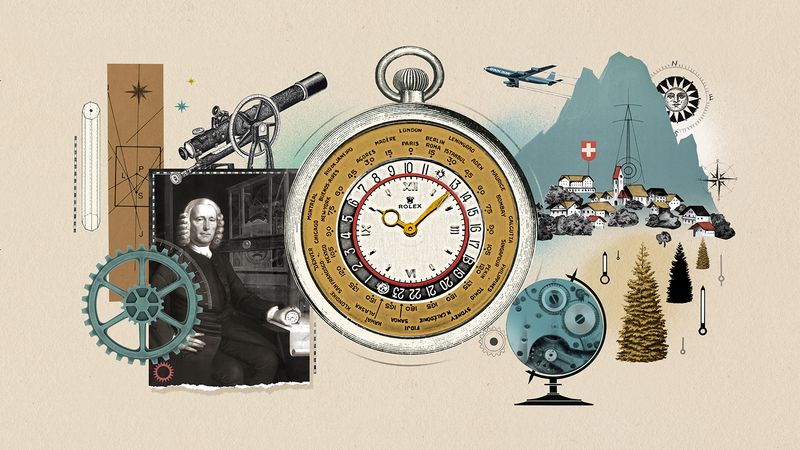THE JOURNAL

The world timer watch has its origins in pocket watches of the late 19th century, but came into its own when brands such as Patek Philippe and Vacheron Constantin brought it to the wrist in the 1940s. As global travel boomed in the following decades, the simpler GMT watch was developed for pilots and has remained popular ever since. But in fact, the history of all mechanical watches is inextricably bound up with travel.
Whether intended for flying, driving or diving, it’s arguable that every precision mechanical watch is ultimately a sailor’s watch. That’s due to a direct lineage tracing back to the efforts of Mr John Harrison, the inventor of the marine chronometer and, by extension, one of the founding fathers of the watch industry.
The 18th-century Yorkshireman nudged aside the vagaries of stargazing at sea with his super-precise (for the era) “chronometer” inventions, which enabled the ascertainment of longitude (how far east or west you are) by comparison of the local midday to midday back at port. Thanks in part to this great leap in marine navigation, Britannia went on to rule the waves and Europe’s chronometer-making industry went into overdrive.
After helping to conquer the oceans and discover the New World, watchmaking went on to keep the 19th century’s newfangled railroads running on time, which in turn – combined with the boom in global telecommunications – inspired 1884’s International Meridian Conference to establish “Greenwich Mean Time”. The world was carved into 24 circumferential time zones, whose “zero degrees” meridian was the line running through southeast London’s leafy suburb.
The arrival of the 20th century saw the rise of intercontinental travel, as the first modern tourists began to traverse these newfangled “time zones” by Pullman carriage and Cunard cabin. But it was the 1950s, in the cockpits and first-class seats of Pan Am’s jet airliners, that the “travel watch” was coined. Pilots, businessmen and other time zone-hopping jet-setters needed a dual-time display to keep their feet on the ground, so to speak: a normal time display to adjust with every international arrival, plus a fixed “home” or “GMT” time indication to ensure you don’t check in with loved ones at the dead of night.

Little-known brand Glycine was the first to release a watch capable of tracking two 24-hour time zones at once (the Airman, which made its debut in 1953). It has remained a cult favourite, but was overshadowed by the arrival the following year of the Rolex GMT-Master. Rolex was first on the scene with its GMT-Master of 1954, a watch that combined local time display with an additional, arrow-tipped GMT hand that completes a sweep of the dial every 24 hours, read from a 24-hour bezel (which also rotates should you want to set a third time zone) – a simple setup that’s barely changed since.
The GMT-Master became standard issue for Pan Am captains – an essential bit of kit relied upon as much as Rolex’s other professional-spec “tool watches”. But with the rise of the globetrotting elite, another form of travel watch soon came into its own, one that had been waiting in the wings since the 1930s: the world timer.
World timer – or Universal Time – clocks and watches had been made sporadically since the 18th century, elaborately engraving locations around a 24-hour dial. Back then, of course, the fastest a man travelled was as rapidly as a horse or sail could carry him, so such timepieces simply demonstrated technical skill on the part of the watchmaker and the cosmopolitan outlook of the owner.
“World timer clocks and watches had been made sporadically since the 18th century, elaborately engraving locations around a 24-hour dial”
Modern world timer watches are rather more functional, typically capable of displaying the time in any of the world’s 24 major time zones and, in the case of a few notable examples, all 38 including Nepal (+05:45) and the Chatham Islands (+12:45). They come in a wide range of varieties, but all owe a debt to the brand that first made a travel watch that travelled with the times: Patek Philippe.
The prestigious Genevan watchmaker counts the World Time among its most popular complications, and one that has achieved cult status thanks to a one-off platinum example from 1946 holding the record price tag for any wristwatch sold at auction for six years: CHF6.5m, hammered at Antiquorum in 2002.
Patek’s world-timing prowess is entwined with the genius inventor of pre-war watchmaking, Mr Louis Cottier. An independent gun for hire, he ran his business out of a room at the back of his wife’s book and stationery shop in Geneva’s quaint suburb of Carouge. There, over the course of 15 years, he produced desk clocks, pocket watches, wristwatches and prototypes. But it was his “heure universelles” that catapulted him into the horological history books.
The bones of what Mr Cottier invented back then are still recognisable in today’s “HU” Patek, as well as those of his other client, Vacheron Constantin, plus every other watchmaker who has pounced since his patent expired. Local time is shown with a central hour and minute hand, which is linked to a rotating 24-hour ring and bordered by either an independently revolving time-zone bezel or outer dial, both of which are manually adjusted. To find out the time in another zone, simply align the local time zone with the 12 o’clock point of the local time dial and the watch will display the correct time in all the world’s zones simultaneously.

